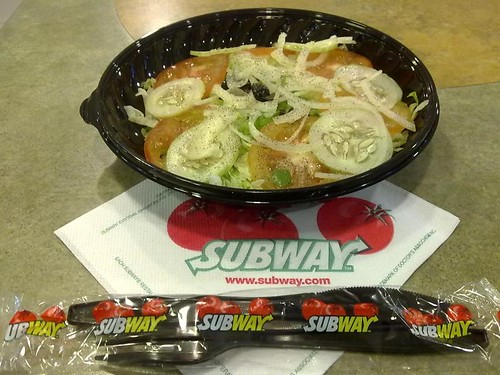Efforts Towards Sustainability
Reducing the Impact
Despite the huge carbon footprints that restaurants and food chains make on our environment. There are many steps that each individual restaurant is taking to try to improve their detrimental impact on the earth. Research was conducted on what these places are saying they do to move toward a more “eco- friendly” means to produce their food.
Brooklyn College
Health
- BC holds a Health Fair once or twice a year during which free cholesterol screenings are offered. This should be advertised widely.
- A new gym facility and other new buildings are under construction.
Metropolitan Foods
- In response to the need for healthier on-campus food options, Metropolitan Food Services has made major improvements to its services at BC, including introducing a new Mexican Bar and offering many healthy options including organic carrot dippers, a tossed salad bar with fresh options, whole wheat pizza, and undressed items in the salad bar.
- According to George Bonn, about 95% of the food products Metropolitan receives do not arrive pre-prepared. The majority of food preparation is done in-house. Mr. Bonn is available to speak to interested people about food preparation.
- Metropolitan offers veggie burgers, which are cooked in the oven, separate from where meat products are prepared.
- In partnership with The Carbon Fund, Metropolitan has introduced plastic to-go mugs available for $3.25. Refills are available for a discounted price (of 20c off). A portion of the proceeds benefit the Carbon Fund.
- Applebee’s supports efforts within and outside of their industry to improve the welfare of farm animals. They rely on experts in the field to provide scientific guidance on animal welfare issues.
- The Applebee’s Restaurant Support Center sets an example by recycling nearly 49 tons of paper material. This equals 831 trees saved, 18,569 gallons of oil saved, 342, 055 gallons of water saved, and 147 cubic yards of landfill space.
- Applebee’s plans to enforce:
– Automatic plumbing fixtures
– Faucets that reduce water usage
– Waterless urinals and/or Very Low Flow (VLF) Fixtures
– Energy Saving products/initiatives
– Devices that automatically turn off lights
– Heating, Ventilation, and Air Conditioning controls that coordinate with kitchen equipment to maximize efficiency.
– Fire Up/Fire Down initiative: A heightened awareness program aimed at educating associates on how to be aware of energy-saving practices throughout the restaurant
– Low volatile organic compounds (VOC) interior paint
- Solar reflective windows
- * Not all items will be implemented in all Applebee’s stores
- In choosing vendors for paper and plastic goods used for the restaurant, they look at factors such as amount of recycled content, the types of bleaches, inks or dyes used, and whether sustainable forestry and production practices were utilized.
- 95% of polystyrene packaging products have been removed and replaced with 100% recyclable packaging, heading towards being polystyrene free.
- Traditional lighting is replaced with compact fluorescent lighting wherever possible.
- Environmental programs focus on reducing waste, such as reuse or recycle potential waste and regular recycling of used cooking oil.
- New LED technology will cause a kWh light load reduction of more than 80 percent per location.
- Pactiv’s PWP Industries created a salad bowl and lid, used by the SUBWAY chain in 23,400 locations around the world, using PETE (polyethylene terephalate – the most recycled of all plastics) made from a minimum of 25 percent post-consumer recycled content. In addition, Pactiv’s PWP Industries, working together with Subway’s, re-designed the bowls to use less plastic material while still being able to hold the same amount of food. The re
- duction allows for more efficient bulk packaging – freeing up space during shipping, and ultimately reducing the amount of trucks on the road needed for deliveries.
The salad bowl will:
- Reduce the amount of plastic material used annually by 844,933 pounds;
- Reduce 25,542 cases of corrugate annually; and
- Reduce the carbon footprint by 24 percent or 84.8 kilograms of carbon dioxide equivalent (CO2e) per thousand containers produced.
- Pactiv’s PWP Industrreducing almost one million transportation miles annuallyies also constructed a plant closer to the Distribution Center, .
Subway’s Steps Towards Sustainability:
- Napkins made with 100 percent recycled fiber with up to 49 percent post consumer content,
- Towel and tissue products made with 100 percent recycled material and up to 75 percent post consumer content.
- 78% of paper packaging contains recycled content.
- Plants and distribution centers strategically located to significantly reduce transportation costs, fuel use and carbon emissions.
- Eight certified eco-stores- and more on the way
In 2009 Subway’s:
- Cut carbon omissions by 123,751 metric tons.
- Saved 17.3 million truck miles and 3 million gallons of diesel fuel.
- Preserved 146,880 trees

Partnerships
Partnering with other organizations is one of the most effective ways to address environmental issues. Target has collaborated with several environmental agencies on special projects to help promote sustainability.
- Retailer Energy Alliance
- United States Environmental Protection Agency Climate Leaders, Stormwater Runoff Strategies Partner, Energy Star and WasteWise
- United States Green Building Council (USGBC), Corporate Sponsor, National Committee (LEED for Retail Application Guide)
- National Recycling Coalition (NRC), Member
- Sustainable Packaging Coalition, Member
- American Industrial Hygiene Association (AIHA), Member
- National Association for Environmental Management (NAEM), Board Member
- National Brownfield Association, Member
- International Council of Shopping Centers, Member
- Recycling Association of Minnesota, Board Member
- Retail Industry Leaders Association Sustainability Initiative, Member
- Food Marketing Institute Sustainability Task Force, Member
- Energy Efficiency
Target continually evaluates new technology to maximize energy efficiency. We’ve upgraded old stores and opened new stores with energy-efficient lighting and HVAC equipment. Installing LEDs in our coolers helps us save 50 percent in energy consumption, and we use motion sensor lights that shut off if guests aren’t in the aisles.
- Demand Management
The vast majority of the current carbon footprint of Target is tied to the energy (electricity and natural gas) used by our stores. To address this, Target is taking steps to better manage the energy-efficient technologies of our stores. For example, we reduced our demand for energy during peak periods through adjustments to our building systems.
- Heating and Cooling
More than 80 percent of the energy consumed in a typical Target store is used by heating and cooling systems, lighting systems and refrigeration systems. Making sure these systems are working efficiently helps us manage our carbon footprint. Target participates in the Retailer Energy Alliance HVAC committee focused on finding innovative solutions to reducing energy consumption in retail facilities.

- Building Thoughtfully
Part of our commitment to the environment includes a respect for the communities and ecosystems we operate in. That’s why we’re seeking ways to save energy, improve efficiency, reduce waste and use sustainable principles as a guide for our design processes. Four Target stores have been certified by the Leadership in Energy and Environmental Design (LEED) rating system, developed by the U.S. Green Building Council (USGBC).
- Brownfield Redevelopment
With Target’s entry into densely populated major metropolitan areas, our expansion strategy includes redeveloping environmentally impaired properties, referred to as “Brownfield” sites. Properties may range from minor spill sites to former Superfund sites. Redevelopment of these properties is guided by a comprehensive understanding of a site’s environmental conditions along with a feasible remediation solution that meets State and Federal cleanup standards. By redeveloping Brownfield sites, Target creates jobs in the community and increases tax revenue to cities and schools.
- Green Roofs
Four Target stores in Chicago are sheltered by a “green” roof, partially or completely covered by hardy plants (typically sedums) growing in a thin layer of soil. The City of Chicago is leading the nation in applying this LID technology. Currently, there are more than 250 green roofs throughout the city. Green roofs filter air pollutants, absorb storm water, modify temperature fluctuations, and provide habitats for birds.

Other Ways of Being More Efficient
- Low emissions of volatile organic compounds (VOCs) from carpet, adhesives, sealants and paints
- Locally manufactured construction materials (when feasible)
- Steel bar joists and concrete building components fabricated from recycled materials
- Recyclable white roofing membranes that reflect the sun’s heat, reduce our stores’ “heat island” effect, and don’t contaminate rainwater runoff
- Natural or cultivated grasses and plants indigenous to the area for lawn and landscaping
- GreenGuard- and Energy Star-certified office furnishings and equipment
- Outdoor lighting fixtures that reduce light pollution and offer full cutoff
Water Conservation
- At Target, water use is important and Target has incorporated several water-saving technologies into our store designs. All Target stores use:
- – Low-flow toilets that meet Federal standards
- – Ultra-low-flow hand-wash faucets that use 80 percent less water and energy.
- They are also testing low-flow urinals that use 50 to 100 percent less water flow than conventional urinals.

Low Impact Development
- When preparing for new store construction, opportunities to use Low Impact Development (LID) technology. LID is the use of innovative design techniques to filter storm-water runoff on site. Installation of bio-swales instead of storm sewers to manage runoff from our parking lots. Rain gardens filter storm water and provide a natural habitat for wildlife.
Preservation
- Natural resources management relates to protecting environmentally sensitive habitats, such as wetlands, surface water and woodlands. Target recognizes the value of preserving natural resources. For example, Target rebuilt the stream embankment along Blacklick Creek, a protected body of water running adjacent to our property, during the construction of our Reynoldsburg, Ohio store. The property adjacent to the creek will be preserved into perpetuity by Target and the site developer with conservation easements. The area now provides a habitat for birds, frogs, butterflies and other wetland wildlife, and helps cleanse storm water.
Non-Retail Goods
- Over the last year, Target has been looking at more environmentally friendly alternatives for the non-retail goods and packaging that we obtain for our stores, distribution centers and headquarters. In 2006, we introduced a kid’s meal box in our Food Avenue® restaurant (at all Target stores) that is made from 100 percent recycled content, with a minimum of 40 percent post-consumer fiber. In 2007 we switched from styrofoam to paper cups in Food Avenue and our headquarters cafeterias. Also, the sleeve for hot beverages now contains 100 percent recycled content with a minimum of 60 percent post-consumer fiber.
Materials and Processes
- At Target, we are committed to providing our guests with great design, which is consistent with protecting and managing our environmental resources. For example, Target encouraged manufacturers to remove harmful Perfluorooctanoic (PFOA) chemicals from products used in fabric and garment processing and to develop PFOA-free chemical alternatives. By mid-2008, all Target products with stain management are PFOA-free.
- We also look for opportunities to reduce polyvinyl chloride (PVC) plastic in our products and packaging. We no longer carry any PVC items in our infant section, and we also updated several packaging items to be PVC-free, including eliminating a box from the Room Essentials 13-piece flatware set, redesigning our alarm clocks from PVC clamshell to a corrugated box, and redesigning drapery holdback packages from a PVC box to a corrugated tray box. These changes eliminate more than 300,000 pounds of PVC per year.
– Popeyes® Louisiana Kitchen is committed to the humane treatment of chickens provided to the restaurants of our system. To uphold this commitment and fulfill our quality standards, we require our suppliers to provide us assurances that they abide by animal welfare guidelines as set forth by the National Chicken Council (NCC), or similar guidelines, that are intended to assure the humane treatment of animals and to promote the production of quality products.





